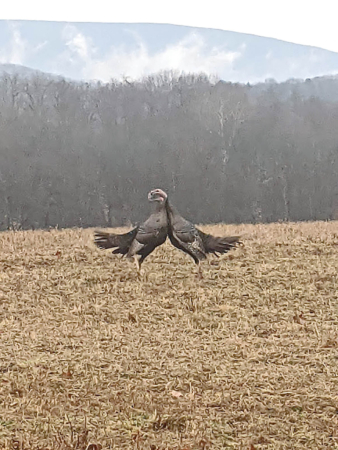I was driving home one morning last week when something strange caught my eye; two turkeys were only a few yards off the road on the bank to my right. I pulled over expecting the turkeys to flee — they didn’t. Now seeing turkeys while driving somewhere around here is certainly not a strange sight, but these two turkeys were engaged in a fierce battle with each other, and what made it all the more intriguing was that they had no concern whatsoever with my close presence. I quickly grabbed my cell phone, pulled up the camera, and started taking pictures out the car window. After shooting some video, I decided to try to get some better shots, so I climbed out of the car; the turkeys continued their combat with no concern at all for my presence.
Now I’ve been hunting turkeys for a long time, and like a lot of other folks, I have seen my share of them while driving and often, the moving car didn’t create a sudden flight, but I certainly didn’t expect to stop the car, get out and then walk in the open towards them.
To my surprise, I walked up into the edge of the field to within 15 or 20 yards of the combatants, and they showed no concern for me whatsoever, and in fact, the battle continued for another ten minutes. As you can see in the photo accompanying this piece, the gobblers have their necks stretched, and one gobbler actually has its beak in the mouth of the other. I don’t know how long they had been fighting before I came by, but I watched for 10 or 15 minutes; another car even pulled up along the edge of the field to watch the unusual spectacle.
So, what was that gobbler combat all about? I’m not sure. I know that gobblers will become more aggressive when spring rolls around and the hunt for receptive females begins. Older, more dominant gobblers want to chase off less mature gobblers. Rival males will try to grasp each other’s head or neck in their bills and try to shove or pull their foe off balance, and the loser could take a thrashing with wings or spurs but what I saw last week was a first for me. We also know that although gobblers may gobble any time of the year, they gobble more during the breeding season. What was interesting was the two gobblers I saw fighting last week never made a peep. Another thought, too, is that I witnessed that battle in the dead of winter months before the spring mating season gets underway, and I’m still baffled that they showed no fear of me.
Well, while we are on the subject of observing turkeys, keep in mind that the Pennsylvania Game Commission is asking people to provide information about turkey flock sightings; they need the date of the sighting, location, and whether the land is public or private. The turkeys may be trapped and banded but then released at the same sight. In some units, a GPS transmitter will be attached to track the turkey’s movements. It’s all part of a large-scale study that will continue through 2025. Biologists from Maryland, New Jersey, and Ohio have also joined the study. Its hoped the research will provide more information that will give us a better understanding of population dynamics and the types of terrain that are utilized.
Here’s hoping that when spring gobbler season rolls around, I’ll have a couple of big gobblers so intent on fighting each other that I can get off a good shot.




